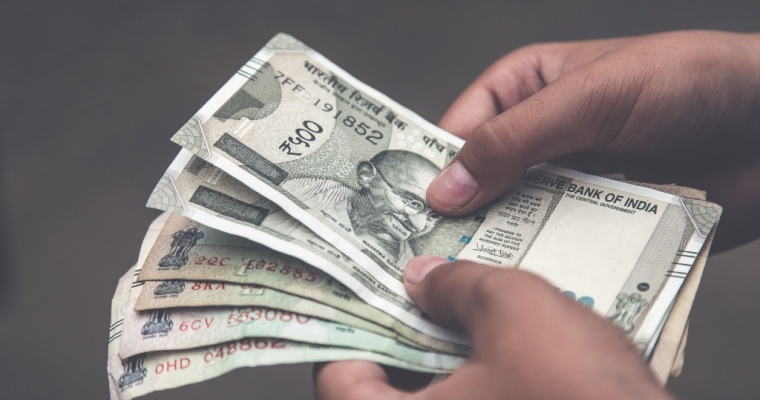Paper Money – What is It and How Does it Work?

Amidst the digitisation of transactions through digital payment gateways, paper money or paper currency has been able to hold its ground, and rightfully so. The history of paper currency dates back centuries with the use of paper money first being recorded in China in the 7th century AD. Over the last couple of centuries, paper currencies have been universally adopted, with banks and central banks strictly controlling their issue.
What is Paper Money?
Paper money is the authorised medium of exchange in most countries. These are banknotes of a country with specific values circulated for all manner of transactions. Paper money is also called as paper currency.
Before the introduction of payment apps and UPI, paper money used to be the only medium to carry out offline transactions. Central banks control the regulation, printing and circulation of paper currency. The value of paper money varies from nation to nation based on that particular nation’s currency value.
How Does Paper Money Work?
In the twenty-first century, almost every country has its own paper money. Governments and central banks work in tandem to formulate decisions about paper money and design and manufacture them.
Please note that paper currency is mostly fiat money. This means it has no intrinsic value. The paper that the money is made of does not have much value if one considers its raw material. Its value lies in what it represents and not in what it is.
Instead, the value of fiat money comes from the backing of the government issuing it. It serves as a legal tender authorising payments for goods and services. Paper currencies are tied to the issuing government. So, the more stable a country is, the higher is its value of currency.
History of Paper Money and Its Importance
Earlier, the barter system was integral to economic exchanges and financial transactions. In ancient times, people used high-value goods like shells, tulip bulbs, peppercorns and beaver pelts as mediums for economic exchanges.
Gradually, people realised the demerits of the barter system. When the demand for these mediums of exchange fell, the entire system became cumbersome and redundant.
In the modern era, paper money has become increasingly important. People realised they could use paper money as a financial transaction medium for any good or item they wanted. Moreover, the most significant advantage lies in the fact that one can circulate it as often as one wishes in an economy.
Also Read
How is Paper Money Made in India?
As per information from the Reserve Bank of India (RBI), manufacturers use 100% pure cotton to make currency notes in India as it is sustainable and long-lasting. Manufacturers use a unique formula, a mixture of 75% cotton and 25% linen, for making bank notes.
After creating this mixture, the manufacturers mix the cotton with a gelatin adhesive solution. It helps the cotton to last longer. Indian currency notes come with many security features which help identify counterfeit notes.
In India, there are four currency presses for printing banknotes. The Government of India owns two of these currency presses through its corporation, Security Printing and Minting Corporation of India Ltd. (SPMCIL). RBI owns the other two through its subsidiary Bharatiya Reserve Bank Note Mudran Private Ltd. (BRBNMPL).
Currency presses of SPMCIL are located at Dewas in Madhya Pradesh and Nashik in Maharashtra. Currency presses of BRBNMPL are situated in Salboni in West Bengal and Mysuru in Karnataka. Mints for coins owned by SPMCIL are located in Mumbai, Kolkata Hyderabad and Noida, respectively.
These bank notes are distributed through a channel of currency chests and small coin deposits owned by various scheduled commercial banks. The RBI, after consultation with the government, issues coins to the places as well as directly to various bank branches.
Paper Money Example
Most countries across the world use paper money or fiat money. India, China, Japan, Australia, Russia, Canada, the United Kingdom and the United States of America are a few examples. Fiat money in various denominations is issued by central banks of these countries.
However, some countries do not issue their own currencies. Euro is a currency used by 19 countries in the European Union. Several countries, such as Zimbabwe, Ecuador, Marshall Islands, etc., have adopted the US dollar as their official currency.
The value of fiat money relies on the stability of the issuing government. This is why countries that undergo an economic recession or political turmoil experience a reduction in the value of their currency.
Printing control of fiat money lies entirely with a country’s central bank. So, for example, in India, it is the Reserve Bank of India that controls the printing and issuing of currencies.
First Paper Money
According to recorded history, Chinese people used the first paper currency in the world. Government officials and wealthy merchants in China in 618 – 907 AD used “flying money”.
These were documents that were similar to bank drafts of the twenty-first century. People used to deposit money in the offices of local officials in exchange for paper receipts. One could redeem these paper receipts for an equal amount of money in a different place in China.
However, as per the rules prevalent in China in those days, individuals could not exchange flying money between themselves. Moreover, it was not available to the general public for their usage. Paper currency was first widely used in China during the Song dynasty era from 960 – 1279 AD.
Paper Money in United States of America
In the US, the Mint Act of 1792 introduced the dollar as the country’s official currency. The following year, American coins were manufactured. When the US Civil War broke out in 1861, the government issued and circulated paper money called greenbacks. Primarily, they were demand notes that were used to finance this war.
The American government took out Greenbacks from circulation in 1862. However, it soon formally announced and issued legal tender notes known as United States notes.
In 1913, the United States of America Government passed the Federal Reserve Act. It established the US Federal Reserve System, which permitted Federal Reserve Banks to issue Federal Reserve Bank notes.
The US dollar – one of the world’s most powerful currencies, became fiat money in 1970. Made of cotton fibre, the dollar comes in various denominations, like $1, $2, $5, $10, $20, $50 and $100.
It is a global reserve currency, and so many countries use the US dollar as their currency. Financial experts measure various currencies of the world against the US dollar. This is because the American currency became economically stronger and resilient after the two world wars.
Paper Money in China
In China, people have used commodity money for a long time. Gradually they got tired of carrying heavy metal coins. Furthermore, the usage of metal coins led to a shortage of certain metals.
During the times of the Tang dynasty, many people started depositing their metal coins with a trusted agent. In return, the agent would issue them a promissory note. This note recorded the number of coins against which an agent issued them. Merchants and traders could use and exchange this promissory note in exchange for coins while trading. These were the first paper money.
In China, the Song dynasty officially issued paper currency, called ‘jiaozi’ for the first time. While trading along the silk route, other kingdoms and dynasties recognised jiaozi’s advantages and started adopting it. However, the money changed with the change in dynasties.
In December 1948, Chinese people got their first ‘renminbi’. It means ‘people’s currency’. The Chinese government issued this currency after the establishment of People’s Bank of China. With the establishment of the People’s Republic of China, the authorities introduced the yuan as the unified legal currency.
Over the years, the Chinese government launched various RMB series. From 2020 onwards, China has begun testing digital currency. If these tests yield successful outcomes, then the e-yuan would be the world’s first digital currency used by a major sovereign economy.
Interesting Facts About Paper Money
Given below are important points to know about paper money:
- Paper money is a legal medium of financial transactions. However, shares, which are units of ownership in a company, can be considered similar to paper money because one can exchange them in the open market for cash.
- Shares enable the shareholder to receive a corresponding share of profits in a company. Business owners often reward their staff with shares in a company instead of paper money.
- Governments worldwide keep updating their security methodologies to safeguard the security of their currencies. In addition, authorities encourage citizens to opt for digital payments instead of carrying paper money as the latter poses security risks.
Final Word
The world has recognised the advantages of paper money, and countries have widely adopted it.
This blog has provided crucial details about the historical significance, workings and usage of paper currencies. However, with an increase in digitisation and adoption of cryptocurrencies, a new form of money may arise.
FAQs
A currency chest is a storehouse for currency notes and rupee coins. Following the directive of the Reserve Bank of India, select scheduled banks have established currency chests. These banks establish storehouses on behalf of RBI and facilitate the distribution of currencies in bank branches in all areas they operate. Presently, there are 3054 currency chests in India.
Paper money is of four types:
• Representative paper money: When the paper money is entirely backed by gold and silver reserves, it is known as representative paper money.
• Convertible paper money: Convertible paper money is when one can convert paper currencies into standard coins.
• Inconvertible paper money: When one cannot convert paper money into standard coins or valuable metals, it is known as inconvertible paper money.
• Fiat money: It is a type of inconvertible paper, neither backed by fiduciary nor metallic reserves.
You should store paper money flatly in protective holders or albums for your collection. Banknotes should be kept in relatively uniform temperature and humidity, away from direct sunlight. Remember to keep the paper money protected as extreme temperatures, air pollution, high humidity, and salt air can negatively affect them.
The average age of currency notes in India is less than one year. However, this is the official age. It does not prohibit a currency note from existing for a longer time than what is its average life cycle.
People cannot spend old paper money if the Government of India has withdrawn their legal tender. However, an individual can exchange old notes with new notes at banks. However, they need to carry valid ID proof. Furthermore, one can exchange soiled, mutilated and torn currency notes in banks.
Disclaimer
This article is solely for educational purposes. Navi doesn't take any responsibility for the information or claims made in the blog.

Customer’s Feedback
No comments found.10 Best Bank for Savings Account in India [Highest Interest Rate 2023]
Savings account is a type of financial instrument offered by several banks. It lets you safely depo... Read More »What is Issuer Identification Number (IIN)- Working and Importance
What is an Issuer Identification Number (IIN)? Banks and financial institutions assign a distinc... Read More »What is a Vostro Account – Meaning, Working and Difference
What is a Vostro Account? A Vostro account is a bank account held by a domestic bank on behalf o... Read More »What is a Solvency Certificate? – Format, Documents Required & How to Apply Online?
What is a Solvency Certificate? A solvency certificate is a legal document furnishing the detail... Read More »What is Merchant Banking – Services, Features, Functions and Example
What is Merchant Banking? Merchant banking is a set of select banking and financial services off... Read More »Automated Clearing House: Objectives, Types and Process
Automated Clearing House is an electronic fund transfer network that manages automatic and direct... Read More »How to Redeem Credit Card Reward Points ?
Credit Card Reward points are types of incentives that customers receive when they use a credit car... Read More »What is Electronic Clearing Service (ECS) in Banking and How does it Work?
What is Electronic Clearing Service (ECS)? Electronic Clearing Service (ECS) is a method of elec... Read More »What are Credit Card Validators and How to Use them?
What is a Credit Card Validator? A credit card validator is a tool that checks the validity of a... Read More »What is Cash Management and How Does it Work?
Managing available capital can make sure that a small business stays afloat. Cash management is an ... Read More »What are Prepaid Expenses? – Definition, Examples, and Journal Entry
Prepaid expenses represent payments made in advance for products or services expected to be incurre... Read More »Increase Credit Card Limit – Important Tips and How to Do It?
The credit card limit is the maximum amount of money you can spend using your credit card. Your cre... Read More »Top 10 Chit Fund Schemes in India in 2023
Chit funds are one of the most popular return-generating saving schemes in India. It is a financial... Read More »10 Best Gold ETFs in India to Invest in April 2023
Gold ETFs or Gold Exchange Traded Funds are passively managed funds that track the price of physica... Read More »10 Best Demat Accounts in India for Beginners in 2023
Creation of Demat accounts revolutionised the way trades were conducted at the stock exchanges. It... Read More »20 Best Index Funds to Invest in India in April 2023
What is an Index Fund? An index fund is a type of mutual fund or exchange-traded fund (ETF) that... Read More »Best Arbitrage Mutual Funds to Invest in India in April 2023
Arbitrage funds are hybrid mutual fund schemes that aim to make low-risk profits by buying and sell... Read More »10 Best SIP Plans in India to Invest in April 2023
What is SIP? SIP or Systematic Investment Plan is a method of investing a fixed amount in ... Read More »10 Best Corporate Bond Funds in India to Invest in April 2023
Corporate bond funds are debt funds that invest at least 80% of the investment corpus in companies ... Read More »10 Best Bank for Savings Account in India [Highest Interest Rate 2023]
Savings account is a type of financial instrument offered by several banks. It lets you safely depo... Read More »































